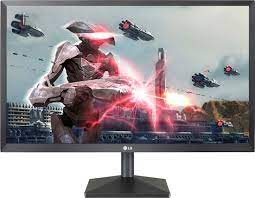December 08,2021
How to buy a monitor: 5 things to consider
by Bin Xu
Learning how to buy a monitor is one of the most important things you can do as a creative. Your monitor displays your projects from start to finish, so you'll want to buy something that'll do your design or editing work justice.

Before investing in a new monitor, consider which features and specs are necessary to produce your best work. For instance, should you buy a top-of-the-line 4K display for graphic design projects when a reasonably-priced 1080p monitor will suffice? Carefully evaluating your needs and budget will prevent you from overpaying for a monitor that doesn't suit the type of creative work you do.
We'll be sharing the five most important things you should consider before purchasing your new display. Knowing how to buy a monitor can make-or-break your design projects, so it pays to be discerning.
Once you've narrowed down your list of must-have specs, check out a few of our buying guides featuring the best 4K monitors, the best curved monitors, or the best 5K and 8K monitors. Even if the monitor you buy has all the features you want, you'll still have to make some key adjustments before you get to work. Bookmark our guide on how to adjust your monitor and use it as a handy set-up reference.
01. How to buy monitors: Purpose
The type of monitor you buy depends on what you intend to use it for most. (Image credit: JGI/Jamie Grill)There are monitors for professional projects, gaming, and business/general use. Pay close attention to the features and specs as each of these monitor types offers something different.
What is a professional monitor?A professional monitor is made with creative projects in mind – graphic design, 3D modelling, photo editing, and video production. You can use a business or gaming monitor for your multimedia work, but professional monitors are often pre-calibrated for optimum colour accuracy, a must-have feature for creatives of all stripes.
Professional monitors tend to use IPS panels, which are known for providing consistent colour accuracy and numerous viewing angles. IPS panels aren't exclusive to professional monitors; you can find them on business and gaming monitors, too. However, professional monitors are pre-calibrated for creative standards, something you'll miss out on if you opt for a different type of monitor.
Another defining feature of professional monitors is the amount of ports it has. This is essential since many creatives tend to use multiscreen setups and plug-in peripherals like drawing tablets. At minimum, a professional monitor will offer multiple ports for USB, DisplayPort, and HDMI connectivity.
What is a gaming monitor?A gaming monitor offers fast response times to display motion graphics and can often be hooked up directly to a game console. This is where Pixel Response Rate comes into the picture. Measured in milliseconds, Pixel Response Rate is the amount of time it takes for a pixel to change from black to white.
You may be able to get away with using a gaming monitor for things like video editing, but you'll lack the high level of calibrated colour accuracy that comes with a professional monitor. Also, many cheaper gaming monitors have twisted nematic (TN) panels, which have excellent refresh rates and response times but poor colour reproduction and viewing angles.
02. How to buy a monitor: Screen resolutionScreen resolution is the number of pixels a monitor can display. In other words, it's the number of dots you get horizontally and vertically. (For instance, 1024 x 768 is 1024 pixels horizontal and 768 pixels vertical.) The higher the resolution, the better the picture and the finer the details.
What resolution should my monitor have?It may be tempting to buy an 8K monitor just because, but unless you're editing multiple 4K videos at once it's not always worth the expense. Here's a brief rundown of minimum screen resolutions you should go for based on project:
Graphic design or 3D modelling: 1360 x 768 (but 1920 x 1080 is more ideal)
Complex 3D designs: 1920 x 1080
Video editing: 1920 x 1080 (HD) or 3840 x 3160 (4K)
Photographers: Varies, but go for the highest you can afford
Should I buy an ultrawide monitor?Ultrawide monitors are becoming more of a staple in creative offices. If you require plenty of screen real estate whilst working, an ultrawide monitor could be a wise investment. You can ditch the 2- or 3-screen setups in favour of a single extra-wide panel that brings everything together seamlessly.
Of course, you'll need to allocate enough space on your desk for an ultrawide monitor. They can span anywhere from 30 to 50 inches wide and boast screen resolutions up to 5,120 x 1,440 (or a 32:9 aspect ratio). Other things to consider before buying an ultrawide monitor are how close you sit to your workstation (farther is better for extra-wide displays) and how much you're willing to spend (wider screens yield larger prices).
03. How to buy a monitor: Features
A curved screen presents more uniform colours and can even help reduce eye strain. (Image credit: Olly Curtis/Future Publishing via Getty Images)Monitors may look alike but the additional features included with some models can raise them above the competition. You may find it worthwhile, for example, to compare a flat screen to a curved screen; each offers a different viewing experience, but it mainly comes down to personal preference. The important thing here is to pay for what you need – not what you don't need.
What design features should I look for in a monitor?We've already touched upon the importance of colour output and screen resolution in selecting the a professional monitor. But another key feature you should take into consideration is monitor design.
When we speak about design, we're not merely talking about aesthetics – although a bezel-less design does look sleek and provides plenty of screen for you to work on. We're referring to ergonomic features like an adjustable arm that allows you to fix the height, tilt, and swivel. You could buy a separate monitor stand for that purpose, but an already-adjustable monitor will help reduce desk clutter.
There are even rotating monitors that can display work vertically in portrait mode. Not only can this save space on your desk, vertical monitors also allow you to fit more content onto the screen. Not to mention, if you regularly design posters or edit portraits, a vertical display could be beneficial in allowing you to see the finer details within their intended orientation.
Does a curved screen make a difference?Curved screens didn't catch on for TVs, but they've been quite popular among creatives who want a wider layout without distortion. Advantages include more uniform colours, more balanced lighting, and less eye strain. However, curved screens do tend to be more expensive than their flat-screen counterparts. And if you're working on a project with a lot of straight lines, a curved screen may put you at a disadvantage when it comes to achieving accuracy.
04. How to buy a monitor: SizeLarge screens are ideal for graphic designers, digital illustrators, and photographers. Typical monitors generally range anywhere from 15 inches up to 30 inches - the size of the monitor being measured diagonally across. Ultrawide monitors can be as large as 50 inches.
Generally speaking, creatives will be fine with a monitor between 27 inches and 32 inches. Unless you edit multiple projects at once or do any other type of multi-tasking, anything larger than 32 inches will be overkill.
How do I measure space for my new monitor?Obviously, you want a monitor that'll fit within the width of your desk. Before buying a new monitor, measure the top of your workstation to get an idea of how much room you have to play with. You'll also have to account for other things that may be on your desk like peripherals, paperwork, and personal effects.
Another thing to consider is how far you're able to sit from your monitor. Since you'll likely be working from a screen that's larger than 20 inches, you'll want to be sitting more than an arm's length away. Ideally, you should be able to sit back in your chair and see everything without leaning forward or squinting.
Alternatively, you can choose to not put a monitor directly on your desk and instead use a monitor arm. An advantage to this is the ability to move the display closer or farther away as needed; it also keeps your workspace cleaner. Check out some of the best monitor arms you can buy right now.
05. How to buy a monitor: Budget
If you multi-task, a multi-screen setup can be helpful. (Image credit: Max Fenton/Construction Photography/Avalon/Getty Images)If you normally work with high resolution images and are constantly switching between tools in the Adobe Suite, you are probably looking for the best picture possible to enhance the colour reproduction. But just know that compared to most general use/business monitors, a professional monitor will cost you.
One of the biggest factors that can affect the price is down to the size of the monitor itself. Cutting back a few inches could be a considerable saving. Just make sure not to go with anything too small – you still want to be able to work on your creative projects comfortably and efficiently.
Should I buy a second monitor?Plenty of designers, illustrators, and photographers use dual monitors for increased day-to-day productivity, especially if they're working from a laptop. Over time, the extra work you'll get done by being more productive will cover the cost of the extra hardware and then some.
Benefits include the ability to have multiple applications running simultaneously without constantly minimizing files. For example your dual monitor setup could comprise of an HTML editor on one screen, and the internet browser on the other.
You could also go for the aforementioned ultrawide monitor for the same purpose if you have the space (and budget) to accommodate.
How can I save on a new monitor?You can find the monitor you need and score a bargain if you search for ongoing deals. Major shopping holidays like Black Friday and Amazon Prime Day feature major discounts on all types of displays. But if you need something sooner rather than later, there are always solid deals to be found. Head below to check out some of the best monitor deals going on right now.
Leave a Reply
Please sing in to post your comment or singup if you dont have account.
Favorite articles

Riviera Nayarit Consolidates Air Connectivity With New Routes
January 03,2022

Looking for a Black Friday Deal? Try Summer 2021 Travel
December 30,2021

Kauai Drops Out of Hawaii’s Pre-Travel Testing Program
December 28,2021
Most popular articles

Riviera Nayarit Proves Resilience With New Hotel Openings
January 04,2022

Large Cruise Ships Return to Alaska
December 29,2021

How to Score Free Disney World Theme Park Tickets in 2021
December 26,2021

Hotel Xcaret Arte To Make Its Debut in July 2021
December 25,2021


Families Can Virtually Visit Santa With Finnair
December 20,2021
Popular articles

Public Donates More Than $100K To Harassed Hotel Worker
January 02,2022

President Biden Signs Law To Restart Cruising in Alaska
January 01,2022

New Proposal Would Create 24-Hour Nightlife Zones in New York City
December 31,2021

Holland America Line Launches 'BIG' Wave Season Offer
December 23,2021
Categories
Favorite articles
Riviera Nayarit Consolidates Air Connectivity With New Routes
January 03,2022
Looking for a Black Friday Deal? Try Summer 2021 Travel
December 30,2021
Kauai Drops Out of Hawaii’s Pre-Travel Testing Program
December 28,2021
Most popular articles
Riviera Nayarit Proves Resilience With New Hotel Openings
January 04,2022
Large Cruise Ships Return to Alaska
December 29,2021
How to Score Free Disney World Theme Park Tickets in 2021
December 26,2021
Hotel Xcaret Arte To Make Its Debut in July 2021
December 25,2021
Families Can Virtually Visit Santa With Finnair
December 20,2021
Popular articles
Public Donates More Than $100K To Harassed Hotel Worker
January 02,2022
President Biden Signs Law To Restart Cruising in Alaska
January 01,2022
New Proposal Would Create 24-Hour Nightlife Zones in New York City
December 31,2021
Holland America Line Launches 'BIG' Wave Season Offer
December 23,2021



